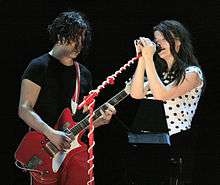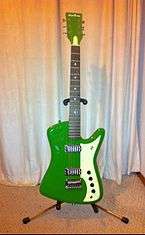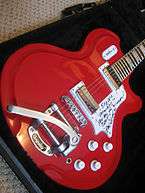Airline (guitar)

Airline was a brand of electric and acoustic guitars made in the United States from 1958-68 by the Valco Manufacturing Co., and sold through the Montgomery Ward mail-order retail company.[1] (Valco was known for its flagship National and budget Supro guitar brands, which were in production until the company's demise in 1968.) Today, old Valco guitars are played by a wide array of bands and artists including: David Bowie (deceased), The Cure, PJ Harvey, Calexico and Jack White of The White Stripes.[2] Due to their re-emerging popularity in contemporary rock music and their relative scarcity in the guitar-sale market, original Res-O-Glas guitars (models made with fiberglass bodies) in excellent condition are known to sell for as much as US$1,500-$3,000.
In the world of guitar collecting, the angular red Airline model, sometimes associated with Jack White, is commonly referred to as the "JB Hutto," after the bluesman and slide guitar artist J. B. Hutto. Hutto was the first popular guitarist to regularly use the guitar in live performances and recordings, and is pictured with the guitar on his Slidewinder and Stompin' at Mother Blues albums.
Airline branded amplifiers were also manufactured, initially by Valco and later by Danelectro.
In the early to mid-2000s, the Eastwood Guitar Co. acquired the rights to use the "Airline" brand-name. Eastwood has never been directly affiliated with the long-defunct Valco company. Original Valco Airline guitars were all made in the United States, whereas today's Eastwood Airline guitars are made in South Korea or China.
Reissue by Eastwood Guitars
Though Eastwood Guitars is not affiliated with the modern day National Reso-Phonic guitar company, the early 1960s JB Hutto Montgomery Airline model was reissued by Eastwood Guitars in the early 2000s under the name of the Airline DLX. The reissue has many noticeable structural and aesthetic differences. Most notably, Eastwood guitars are built with chambered mahogany bodies as opposed to the hollow fiberglass (Res-O-Glas) bodies used for the originals.[3] This difference in body materials gives the reissue a much more traditional electric guitar feel and tone, whereas the original Airline is noted for its unconventional playing feel and response.[4][5] Additionally, the reissue has an adjustable truss rod, accessible from the headstock, while the original had a non-adjustable steel reinforced neck. The aesthetic differences between the original and the reissue include: different tuning heads, (the newer model having greenish knobs, as opposed to the original white knobs), different pickups (original pickups were single coils, often mistaken for humbuckers, whereas Eastwood reissues have actual humbuckers; although Eastwood now offers "vintage-voiced single-coil" (VVSC) units, with large Gibson-style mounting rings), a slightly different shaped pickguard (the original pickguard extended further into the center of the body between the pickups and always included a black stripe along the edge), Gibson-type block inlays on the fingerboard (original inlays were smaller and more rectangular), and finally, original Airlines were usually equipped with white volume and tone knobs, not black like the reissues.
To attempt to further approximate the look of the original JB Hutto Airline beyond the first reissue, Eastwood Guitars released the "Airline '59 Custom" two and three pickup models in December 2008, which come with striped pickguards and rubber bound bodies, in the spirit of the originals.
Res-O-Glas Guitars by Guitar Kits USA


In 2005, Guitar Kits USA purchased the "Res-O-Glas" trademark and began manufacturing customizable fiberglass guitar bodies in the popular J.B Hutto style of the Airline guitar, as well as the Belmont body style originally made by the Valco Manufacturing Co.[6]
Gallery
 1962 Airline Town and Country (refinished)
1962 Airline Town and Country (refinished)
%2C_Valco_Manufacturing_Co._-_MIM_PHX.jpg) c.1960 Airline Double Pickup Bass
c.1960 Airline Double Pickup Bass.jpg) Harmony H44 Stratotone (right)
Harmony H44 Stratotone (right).jpg) c.1961 Airline Model 9000 amp in CRT TV style
c.1961 Airline Model 9000 amp in CRT TV style Eastwood Airline Tuxedo (reissued)
Eastwood Airline Tuxedo (reissued) Eastwood Airline Bighorn (reissued)
Eastwood Airline Bighorn (reissued) Eastwood Airline Coronado DLX (reissued)
Eastwood Airline Coronado DLX (reissued)
See also
- Valco
- National String Instrument Corporation — origin of Valco, via National Dobro Corporation
- Supro
- Kay Musical Instrument Company
- Harmony Company
- Eastwood Guitars
References
- ↑ Electric Guitars: the Illustrated Encyclopedia Edited by Tony Bacon. San Diego: Thunder Bay, 2000. Pp. 18 & 242.
- ↑ Robinson, Mike (April 14, 2014). MyRareGuitars.com. Retrieved October 7, 2014
- ↑ Electric Guitars: the Illustrated Encyclopedia Edited by Tony Bacon. San Diego: Thunder Bay, 2000. Pp. 18 & 243.
- ↑ "White Heat: the White Stripes' 21st Century Blues" by Darrin Fox. Guitar Player Magazine, edited by Michael Molenda, June 2003, Pp.72.
- ↑ "The House That Jack Built" by Christopher Scapelliti. Guitar World Magazine, edited by Brad Tolinski, May 2004, Pp.150.
- ↑ http://www.guitarkitsusa.com/4.html
- ↑ "1962 Harmony Roy Smeck Stratotone Model H7208". Traynor Tweaks (kilback.net).
Manufactured by Harmony in Chicago, USA, in mid-1962. Similar to Harmony Stratotone H49 Jupiter, but different pickups and controls.
External links
![]() Media related to Airline Guitars at Wikimedia Commons
Media related to Airline Guitars at Wikimedia Commons
- "Eastwood Guitars". — home of reissued Airline guitars.
- "Guitar Kits USA". — home of Res-O-Glas guitar kits.